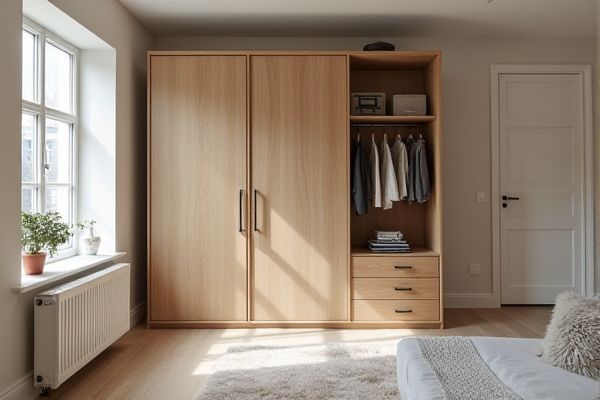
A stationary wardrobe offers sturdy, fixed storage ideal for keeping your clothes organized with a timeless design, while a rolling wardrobe provides mobility and flexibility, perfect for maximizing space and easy access in dynamic environments. Discover which wardrobe style best suits your needs and transforms your room by reading the full article.
Table of Comparison
| Feature | Stationary Wardrobe | Rolling Wardrobe |
|---|---|---|
| Mobility | Fixed, does not move | Equipped with wheels for easy relocation |
| Space Efficiency | Requires dedicated permanent space | Flexible placement, ideal for small spaces |
| Durability | Typically more robust and stable | May be less sturdy due to moving parts |
| Design | Varied traditional and modern styles | Often minimalist to facilitate movement |
| Weight Capacity | Higher weight capacity support | Lower weight capacity due to wheels |
| Installation | Usually requires more setup and positioning | Simple setup, portable |
| Ideal Use | Permanent bedroom or closet solution | Temporary or flexible storage needs |
| Cost | Generally higher price range | Typically more affordable |
Understanding Stationary and Rolling Wardrobes
Stationary wardrobes are fixed storage units designed for long-term placement, offering stable and spacious organization for clothing and accessories. Rolling wardrobes feature wheels or casters, providing mobility and flexibility for easy relocation within rooms or between spaces. Choosing between stationary and rolling wardrobes depends on factors such as room layout, storage needs, and the desire for portability.
Key Differences Between Stationary and Rolling Wardrobes
Stationary wardrobes offer fixed, stable storage solutions ideal for permanent room setups, featuring robust construction and larger capacity, while rolling wardrobes provide mobility with wheels for easy relocation and flexible space management. The main differences include weight capacity, installation requirements, and adaptability; rolling wardrobes tend to be lighter with less maximum weight but can be moved to optimize your living space. Choosing between these options depends on your need for either stability in storage or versatility in wardrobe placement.
Space Optimization: Which Wardrobe Fits Better?
Stationary wardrobes maximize vertical space with fixed dimensions ideal for rooms requiring consistent storage without movement, often featuring built-in shelves and compartments to utilize every inch efficiently. Rolling wardrobes provide flexible space optimization by allowing easy repositioning in small or multipurpose areas, adapting storage location based on immediate needs while enhancing room functionality. For tight spaces, rolling wardrobes excel by enabling rearrangement and access, whereas stationary wardrobes suit permanent setups prioritizing structural storage capacity.
Mobility and Flexibility: The Rolling Advantage
Rolling wardrobes offer superior mobility and flexibility compared to stationary wardrobes, featuring sturdy caster wheels that allow easy relocation within any space. This mobility supports dynamic room layouts and convenient cleaning or reorganization without heavy lifting. The adaptability of rolling wardrobes suits both temporary setups and evolving storage needs, making them ideal for modern living environments.
Durability and Stability Comparison
Stationary wardrobes typically offer greater durability due to their solid construction and fixed placement, providing enhanced long-term stability for heavy clothing storage. Rolling wardrobes feature wheels for portability but often sacrifice some stability and sturdiness, making them less ideal for heavy loads or uneven floors. Choosing between the two depends on prioritizing either permanence and strength or mobility and convenience.
Style and Design Variations
Stationary wardrobes offer a wide range of classic and contemporary style options with fixed structures that complement traditional and modern interiors, while rolling wardrobes provide versatile design variations with mobility features, making them ideal for flexible spaces. You can choose from sleek, minimalist designs in stationary wardrobes or opt for compact, portable designs in rolling wardrobes that combine functionality with aesthetic appeal. Both types enhance room decor but differ in spatial adaptability and design focus.
Installation and Assembly Requirements
Stationary wardrobes typically require more extensive installation, involving wall anchoring and precise measurements to ensure stability and alignment, often needing professional assembly due to their size and weight. Rolling wardrobes feature simpler assembly with pre-fitted wheels and modular components, allowing for quick setup without permanent fixtures, ideal for flexible room arrangements. The choice influences time, effort, and tools needed, with stationary units demanding a more fixed and labor-intensive approach compared to the portability and ease of rolling wardrobes.
Cost Analysis: Stationary vs Rolling Wardrobes
Stationary wardrobes typically cost less upfront due to simpler construction and fixed placement, making them a budget-friendly option for long-term use. Rolling wardrobes, equipped with wheels and flexible design, often come at a higher price but offer mobility that justifies the investment for those needing space versatility. Your choice depends on balancing initial expense against functionality and room layout adaptability.
Best Use Cases for Each Wardrobe Type
Stationary wardrobes are ideal for permanent spaces with limited mobility needs, offering greater stability and larger storage capacity for seasonal clothing and bulky items. Rolling wardrobes excel in flexible environments like dorm rooms or small apartments, allowing easy relocation and accessibility for frequently used outfits. Choosing between them depends on space constraints, desired mobility, and the frequency of wardrobe rearrangements.
Choosing the Right Wardrobe for Your Needs
Stationary wardrobes offer sturdy, permanent storage solutions ideal for maximizing bedroom space with fixed dimensions, while rolling wardrobes provide versatile, mobile storage that adapts to changing room layouts and temporary needs. Consider factors such as room size, frequency of rearrangement, and accessibility when choosing between stationary and rolling wardrobes to optimize functionality. Prioritize material durability, weight capacity, and ease of assembly to ensure the wardrobe meets your long-term storage requirements effectively.
 homyna.com
homyna.com